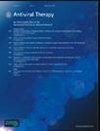健康成人口服TLR-7激动剂JNJ-64794964的安全性、耐受性、药代动力学和药效学
IF 2.3
4区 医学
Q4 INFECTIOUS DISEASES
引用次数: 5
摘要
这项I期、两部分、首次人体研究评估了健康成人口服toll样受体-7激动剂JNJ-64794964 (JNJ-4964)单次递增剂量(SAD)和多剂量(MD)的安全性/耐受性和药代动力学/药效学。方法在SAD期,受试者在禁食状态下接受JNJ-4964 0.2 (N = 6)、0.6 (N = 6)、1.25 (N = 8)或1.8 mg (N = 6)或安慰剂(N = 2/剂量队列)。在≥6周洗脱期后,评估1.25 mg组的食物效应。在MD阶段,参与者每周(禁食)接受JNJ-4964 1.25 mg (N = 6)或安慰剂(N = 2),持续4周。参与者随访4周。结果无严重不良事件发生。10/34 (SAD)和5/8 (MD)参与者报告了可能与JNJ-4964相关的轻度至中度(≤2级)、短暂、可逆的ae。5名(SAD)参与者在给药后24-48小时出现发烧/流感样不良反应,与血清干扰素α水平≥100 pg/mL和淋巴细胞减少(<1 × 109/L)一致,并在给药后约96小时消退。1名参与者(MD)在随访期间出现无症状的1级AE视网膜渗出物(棉絮斑),观察6周后消退。JNJ-4964表现出剂量比例药代动力学,吸收快(最长0.5-0.75 h),分布快,终末半衰期长(150-591 h)。总体而言,JNJ-4964药代动力学参数在喂养状态和禁食状态下无显著差异。JNJ-4964具有潜在抗hbv活性的剂量依赖性和瞬时诱导细胞因子,包括血清中的干扰素-α、IP-10、IL-1 RA和/或MCP-1,以及干扰素刺激基因(ISG15、MX1和OAS1)。结论在健康成人中,JNJ-4964总体耐受良好,表现出剂量比例药代动力学和诱导的细胞因子/ isg,可能具有抗hbv活性。本文章由计算机程序翻译,如有差异,请以英文原文为准。
Safety, tolerability, pharmacokinetics, and pharmacodynamics of oral JNJ-64794964, a TLR-7 agonist, in healthy adults.
BACKGROUND
This Phase I, two-part, first-in-human study assessed safety/tolerability and pharmacokinetics/pharmacodynamics of single-ascending doses (SAD) and multiple doses (MD) of the oral toll-like receptor-7 agonist, JNJ-64794964 (JNJ-4964) in healthy adults.
METHODS
In the SAD phase, participants received JNJ-4964 0.2 (N = 6), 0.6 (N = 6), 1.25 (N = 8) or 1.8 mg (N = 6) or placebo (N = 2/dose cohort) in a fasted state. Food effect was evaluated for the 1.25 mg cohort following ≥6 weeks washout. In the MD phase, participants received JNJ-4964 1.25 mg (N = 6) or placebo (N = 2) weekly (fasted) for 4 weeks. Participants were followed-up for 4 weeks.
RESULTS
No serious adverse events (AEs) occurred. 10/34 (SAD) and 5/8 (MD) participants reported mild-to-moderate (≤Grade 2), transient, reversible AEs possibly related to JNJ-4964. Five (SAD) participants had fever/flu-like AEs, coinciding with interferon-α serum levels ≥100 pg/mL and lymphopenia (<1 × 109/L), between 24-48 h after dosing and resolving approximately 96 h after dosing. One participant (MD) had an asymptomatic Grade 1 AE of retinal exudates (cotton wool spots) during follow-up, resolving 6 weeks after observation. JNJ-4964 exhibited dose-proportional pharmacokinetics, with rapid absorption (tmax 0.5-0.75 h) and distribution, and a long terminal half-life (150-591 h). Overall, no significant differences in JNJ-4964 pharmacokinetic parameters were observed in the fed versus fasted state. JNJ-4964 dose-dependently and transiently induced cytokines with potential anti-HBV activity, including interferon-α, IP-10, IL-1 RA, and/or MCP-1, and interferon-stimulated genes (ISG15, MX1, and OAS1) in serum.
CONCLUSIONS
In healthy adults, JNJ-4964 was generally well-tolerated, exhibited dose-proportional pharmacokinetics and induced cytokines/ISGs, with possible anti-HBV activity.
求助全文
通过发布文献求助,成功后即可免费获取论文全文。
去求助
来源期刊

Antiviral Therapy
医学-病毒学
CiteScore
2.60
自引率
8.30%
发文量
35
审稿时长
4-8 weeks
期刊介绍:
Antiviral Therapy (an official publication of the International Society of Antiviral Research) is an international, peer-reviewed journal devoted to publishing articles on the clinical development and use of antiviral agents and vaccines, and the treatment of all viral diseases. Antiviral Therapy is one of the leading journals in virology and infectious diseases.
The journal is comprehensive, and publishes articles concerning all clinical aspects of antiviral therapy. It features editorials, original research papers, specially commissioned review articles, letters and book reviews. The journal is aimed at physicians and specialists interested in clinical and basic research.
 求助内容:
求助内容: 应助结果提醒方式:
应助结果提醒方式:


